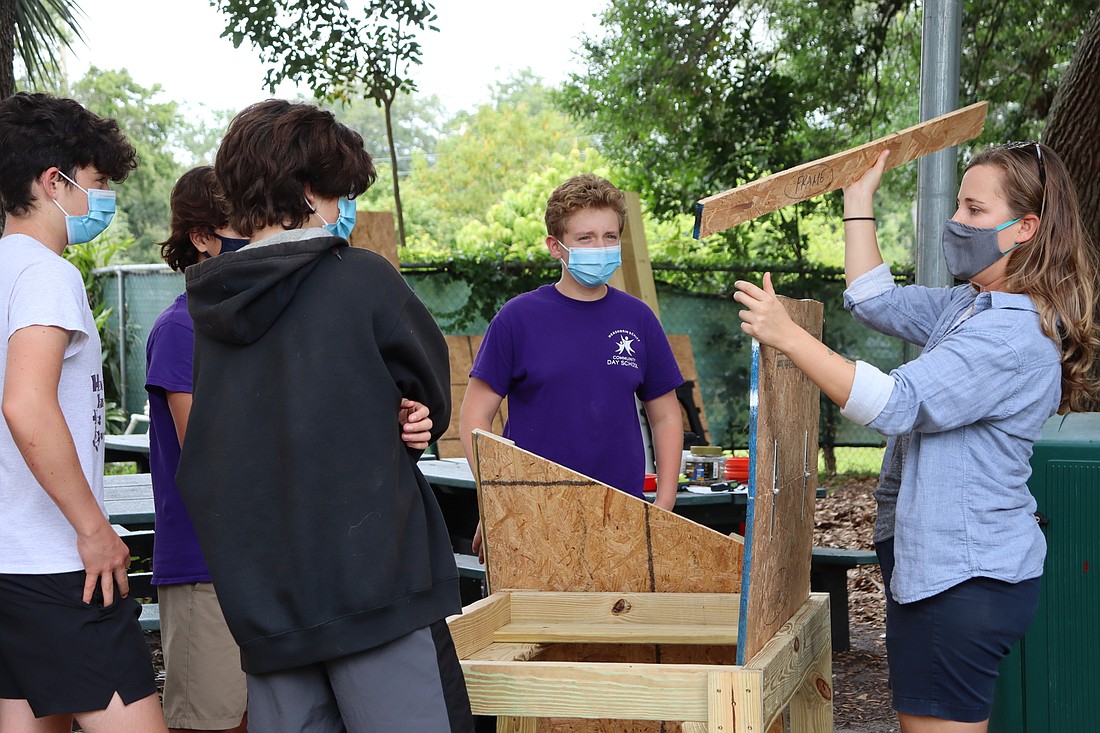- July 26, 2024
-
-
Loading

Loading

Students at the Hershorin Schiff Community Day School recently stepped out of the classroom and into the garden to help build a home for a family of four.
Seventh and eighth grade students first planned the home using geometry and algebra. They then priced materials before finally using saws to cut the lumber necessary for the home.
Working together, they put up wall by wall until they had completed a two-story home that fit the family’s needs: a large living space and individual bedrooms.
No interior design decisions had to be made or plumbing work figured out because the students’ client family has feathers, wings and beaks.
The middle school students were creating a new chicken coop for the school’s four chickens: Hope, Coco Puff, Pepper and Buttercup.
The build was part of a legacy project the middle school students will leave behind for future generations.
Michel Mayer, an eighth grade student who has attended Community Day School for four years, said he was proud to build something future students will enjoy.
“It makes me pretty happy that after all this time in the school I get to help with this project, and it will be one of the first at the new school, which is pretty exciting,” Mayer said.
Community Day School will open its new, larger campus for the 2021-22 school year. Because the coop will be transported to the school’s new campus at 4335 Wilkinson Road, just west of McIntosh Road, it had to be built in two parts, which challenged the students.
Agricultural sciences teacher Meg Lea, who led the project, said in a typical year, eighth graders volunteer within the community and take part in school improvement projects throughout the course of their final year.
However, because of COVID-19, the students haven’t been able to take part in traditional activities, which led them to think outside the box.
“They have wondered out loud about what thing future students would have to look back on to say this was their contribution,” Lea said. “Between their love of our hens and their aptitude for math and engineering, this project came together pretty organically and became the perfect way for our middle school students to leave their mark on our new campus.”
Students had about two weeks to pull the project together, and although it was a short turnaround, Mayer said the most challenging part wasn’t the time constraint.
“The hardest part was definitely looking at the math and thinking we had it figured out, and then we looked at the prices of materials and found out we didn’t,” Mayer said. “But it was so fun. We felt like we were really responsible for it, so it’s exciting to see it all come together.”
The project follow’s the school’s philosophy of project-based learning. A tenet of Community Day School is tikkun olam, or behaving in a way that is constructive and beneficial to society.
A method the school uses to teach that tenet is its outdoor garden and classroom, which teaches students the benefits of agricultural science and caring for live creatures through hands-on learning.
Head of School Dan Ceaser said there’s a correlation between student engagement and student achievement, so school leaders try to get students involved as often as possible.
“When kids feel like they’re partners, they’re invested in their learning, and they know why they’re learning, and they feel it’s connected to their lives, they give more effort to perform at a higher level,” Ceaser said. “So projects like these not only make school more fun, but they make kids more invested.”
Ceaser said such projects as the chicken coop allow students to utilize the necessary leadership to create projects not just for the grade but also to feel a part of the community.
“We want our kids at the end of the day to have the ability to look back on their learning and say, ‘I did this not because I was told to do it but because it matters to me,’” he said.